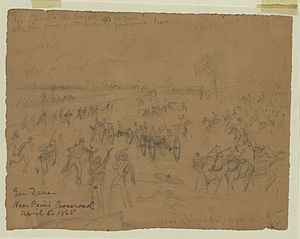Alexander Calvin Elliott facts for kids
Alexander Calvin Elliott (born 1831 – died February 9, 1905) was a brave soldier from the United States. He fought for the Union Army during the American Civil War. Alexander Elliott was a sergeant in Company A of the 1st Pennsylvania Cavalry. He earned the highest award for bravery in the U.S., the Medal of Honor. He received this award for his actions at Paines Crossroads, Virginia, on April 5, 1865.
Contents
Joining the Civil War
Alexander Elliott was born in Beaver County, Pennsylvania, in 1831. When the Civil War began, he was one of the first to answer President Abraham Lincoln's call for volunteers. This call came after Fort Sumter fell to Confederate troops in April 1861.
Elliott joined the army in Pittsburgh, Pennsylvania, on August 23, 1861. He officially became a sergeant with Company I of the 1st Pennsylvania Cavalry. This group was also known as the 44th Pennsylvania Volunteers. At the time, records described him as a 32-year-old farmer. He was from Beaver County, stood 5 feet 10.5 inches tall, and had black hair and brown eyes.
Fighting for the Union
At first, Elliott and his regiment were assigned to guard and scout duties. They worked in Maryland and Virginia during the end of 1861 and early 1862. In March 1862, his group joined the Army of the Potomac. They then fought in many important battles.
Key Battles and Campaigns
Some of the battles they fought in included the Battle of Cross Keys in June 1862. They also fought in the Battle of Cedar Mountain and the Second Battle of Bull Run in August. Later, they were part of the Battle of Antietam and the Battle of Fredericksburg in late 1862.
In January 1863, Elliott's regiment took part in Major-General Ambrose Burnside's "Mud March." This was a very difficult march in bad weather. After this, they guarded areas between Falmouth and Port Conway. They then joined the Chancellorsville Campaign in April. They also fought in the Battle of Aldie in June.
Elliott and his unit were then part of the Gettysburg Campaign. They fought in the famous Battle of Gettysburg from July 1-3, 1863. After this, they chased the enemy from Pennsylvania back into Maryland and Virginia. They continued to fight in battles like the Battle of Culpeper Court House and the Bristoe Campaign.
Re-enlisting and More Battles
On January 1, 1864, Elliott decided to join the army again. His regiment then took part in the Campaign from the Rapidan to the James. This included the Battle of Todd's Tavern in May. They also joined Lieutenant-General Ulysses S. Grant's Overland Campaign. This campaign included battles like the Battle of Yellow Tavern and the Battle of Cold Harbor.
During operations on June 21, Elliott was seriously injured by a gunshot wound. After he recovered, he was moved to an artillery battery in September. His regiment then joined the Richmond-Petersburg Campaign. They fought in battles like Poplar Springs Church and Battle of Hatcher's Run.
Earning the Medal of Honor
Alexander Elliott performed the brave act that earned him the U.S. Medal of Honor. This happened at Paine's Cross Roads, Virginia, on April 5, 1865. During this battle, he bravely captured the flag of an enemy regiment. Capturing an enemy flag was a very courageous act.
After this, Elliott's regiment fought at Farmville on April 7. Their last major battle was the Battle of Appomattox Court House on April 9. This battle led to the surrender of the Confederate States Army by General Robert E. Lee. Elliott and his regiment also marched in the Union's Grand Review of the Armies in May. He was honorably discharged from the army on June 17, 1865. This means he finished his service with good standing.
Life After the War
After leaving the military, Alexander Elliott went back home to Pennsylvania. In 1866, he married Isabella Young (1835–1905), who was from Ohio. Their son, Clarence (1868–1935), was born in Poland, Ohio, in 1868. Alexander and his family lived in that town until at least 1890.
Alexander Elliott passed away in Philadelphia, Pennsylvania, on February 9, 1905. After his funeral, he was buried at Highwood Cemetery in Pittsburgh.


